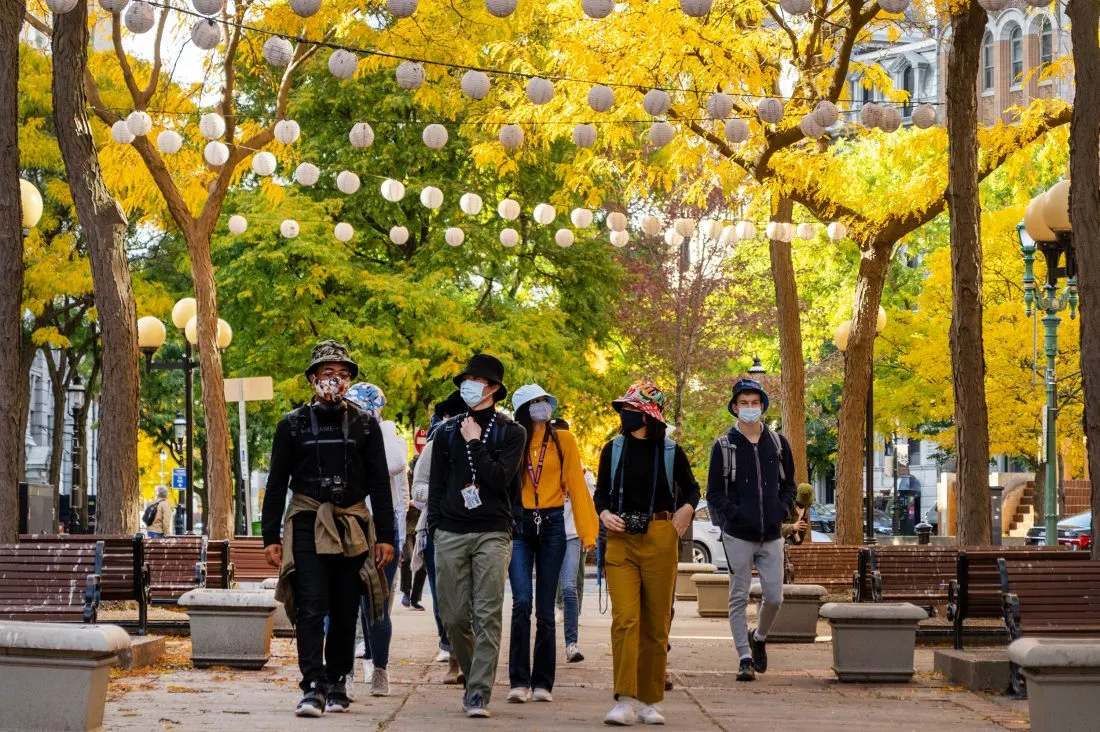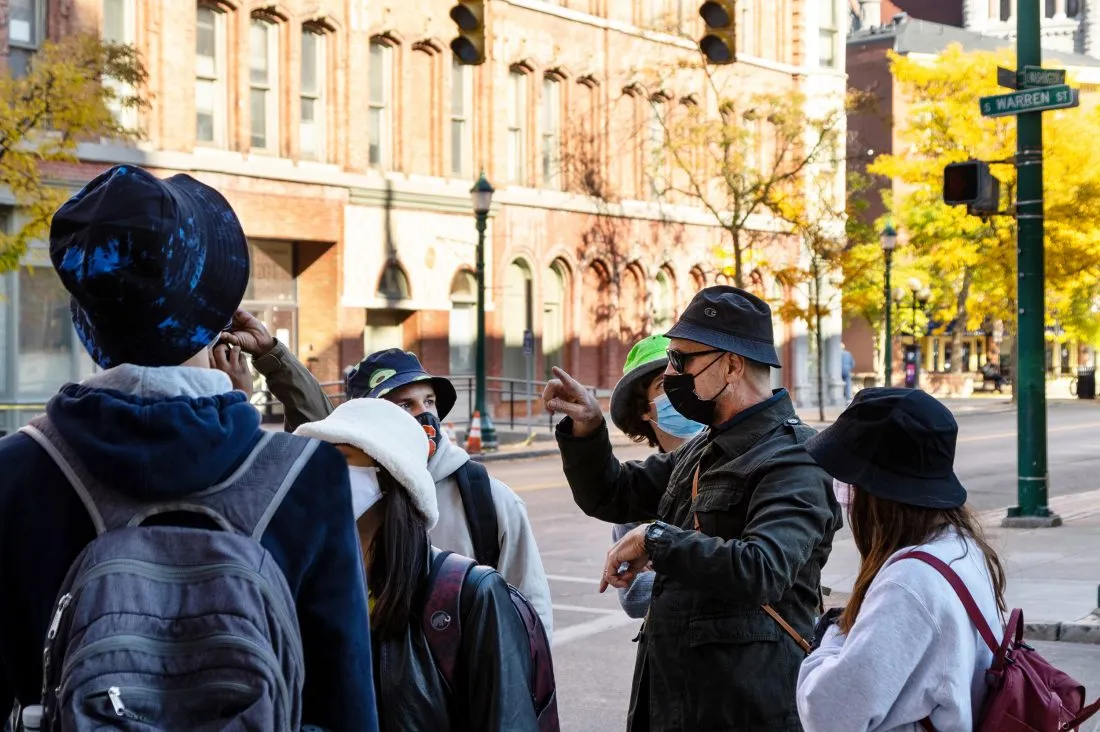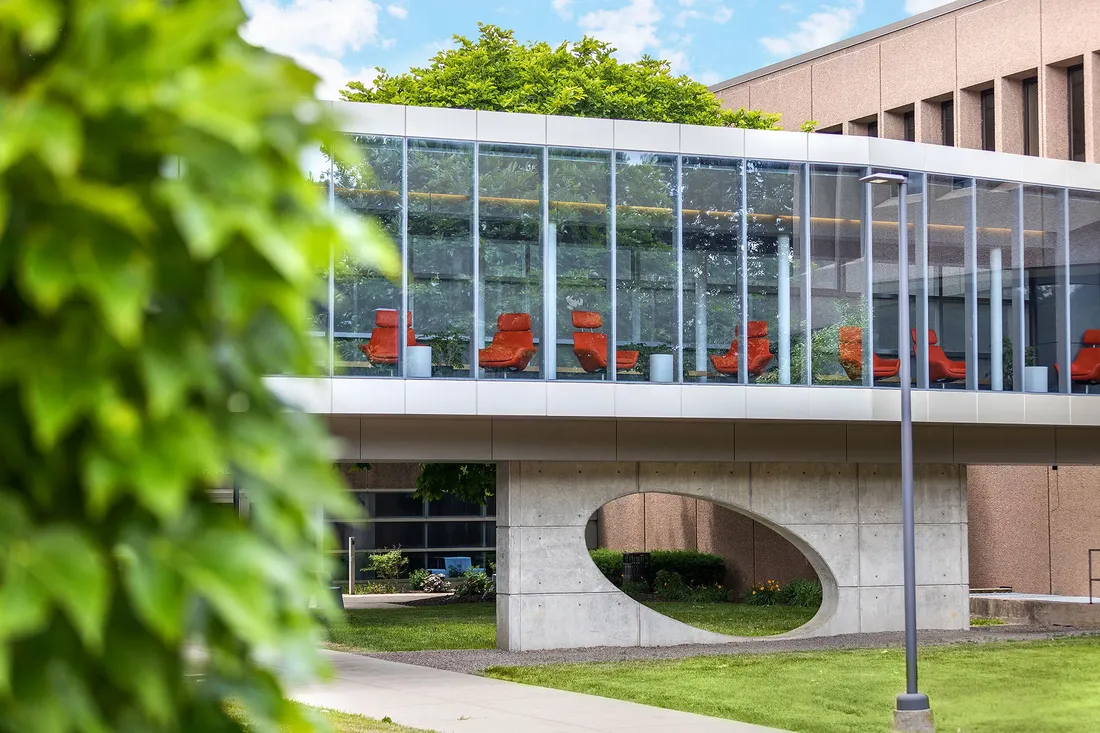
For first-year architecture students, Armory Square was the backdrop for a recent photography challenge based on street scenes.
On a sunny Saturday in downtown Syracuse this fall, a group of young people wearing bucket hats pointed their cameras at the local architecture. On a mission to engage with their peers and learn new things, these Syracuse University students-turned-tourists for a day were taking part in a creative initiative of the peer advisors in the School of Architecture .
For the inaugural outing of the “Buckets and Photos” event, 14 first-year students, their peer advisors and their school dean took in the sights and completed photo challenges inspired by architecture. “The goal was to get students outside, show them the downtown community, and share enthusiasm for both architecture and photography,” says fifth-year student Aaron Cass, a member of the peer advisor creative team who designed the event. Earlier this semester, advisors organized a gathering of first-year students to explore painting amid the architectural and natural beauty of Thornden Park.
The School of Architecture’s peer advising team helps new students with the transition from high school to college through activities and individual support designed to help them feel at home and make the most of their Syracuse experience. “At the start of the semester, peer advisors and first-year students always comment that they would like to have more engagement with one another after orientation weekend,” says recruitment specialist Dana McQuillan. “New students embrace opportunities to connect in person, and our peer advisors have done a wonderful job creating clever ways to engage them.”
Points of Perspective

At the site of the installation Immersive Cloud, by assistant professor of architecture Daekwon Park, students focused on a theme of reflection. (Photo by Akshara Raman)
Just after lunchtime on event day, the Buckets and Photos group began its exploration in renowned Clinton Square before moving on to Hanover Square, where they compared the spatial qualities of the two public squares as gathering spaces. At Firefighters Memorial Park on South Street, they examined Immersive Cloud, a sculptural installation by assistant professor of architecture Daekwon Park. The commissioned piece features a series of steel disks that form an undulating pattern to mirror the sky and trees. As Park writes in an artist’s statement, the sculpture is intended to serve as a medium for immersive experiences and a platform for fostering social interactions. “Our theme here was reflection,” says Cass.
Next, the group looked at the Everson Museum of Art, a fine example of brutalist architecture designed by the revered master I.M. Pei. “Pei designed many famous works, including the pyramid at the entrance to the Louvre,” explains Cass. “He also designed the Newhouse I building on our own campus.”
The group practiced posing people with objects in the garden at the museum, then flexed their observational instincts to capture architectural elements of surrounding buildings as they strolled through Columbus Circle and Armory Square. By late afternoon they looked at the Nancy Cantor Warehouse on Warren Street and wrapped up the tour beside One, Two, Three by Sol LeWitt ’49. Located in the plaza of the James M. Hanley Federal Building, this 29-foot aluminum installation was commissioned in 1962 as part of the General Services Administration Art-in-Architecture Program.
Leading Lines to Learning

A first-year architecture student observes the leading lines in a section of a downtown park.
Student participants agreed all of this hands-on learning was fun. “I learned a lot of interesting things about Syracuse, like how the Erie Canal affected the architecture of the city—and the dean shared lots of little facts about the trees!” says Sofia Izer, a first-year student from Montgomery, Alabama. Izer says she didn’t know much about photography before the tour, and she enjoyed the opportunity to learn about leading lines, depth and framing a subject.
As Cass selected stops on the tour, he considered how these principles relate to both photography and architecture. Passionate about architecture as his field of study and a self-described hobbyist of photography, Cass started taking pictures while serving in Afghanistan with the U.S. Army. He currently works as a photography intern in the division of marketing at Syracuse University. It just so happens that architecture school dean Michael Speaks has a personal interest in photography, too, and he helped lead the tour. Speaks hosted lunch for the group and provided colorful bucket hats for the participants to wear. “Dean Speaks really likes his bucket hats,” jokes Cass, adding they helped identify and build a sense of connection within the group.

School of Architecture Dean Michael Speaks joined first-year students for a walking tour of downtown Syracuse.
Speaks appreciates the peer advisors’ role in guiding new students and admires the hard work of the organizers, including Cass and sophomores Katie Eveleth and Grace Rankin. “These students are the heart and soul of our school and the future leaders in our discipline and profession," says Speaks. "I am always inspired by them!”
Support Through Common Challenges
In addition to social activities, the peer advisors host study sessions where they meet with students in various locations around campus to work in small groups on their sketchbook assignment for the required course ARC 181 Representation. Students are encouraged to support each other through common interests and challenges, even with some restrictions due to the pandemic.
“We are definitely getting to know each other, thanks to group projects and events like these,” Izer says. Other interactive events for first-year architecture students include “The Space and Structure of Salt City,” a walking tour led by professor and undergraduate program chair Lawrence Davis, and “P umpkitecture ,” a carved pumpkin competition.
Peer advisors, staff and faculty are committed to helping new architecture students connect with each other in activities that might become new traditions. “I believe it’s part of a silver lining of some unprecedented challenges of this year,” says McQuillan.


